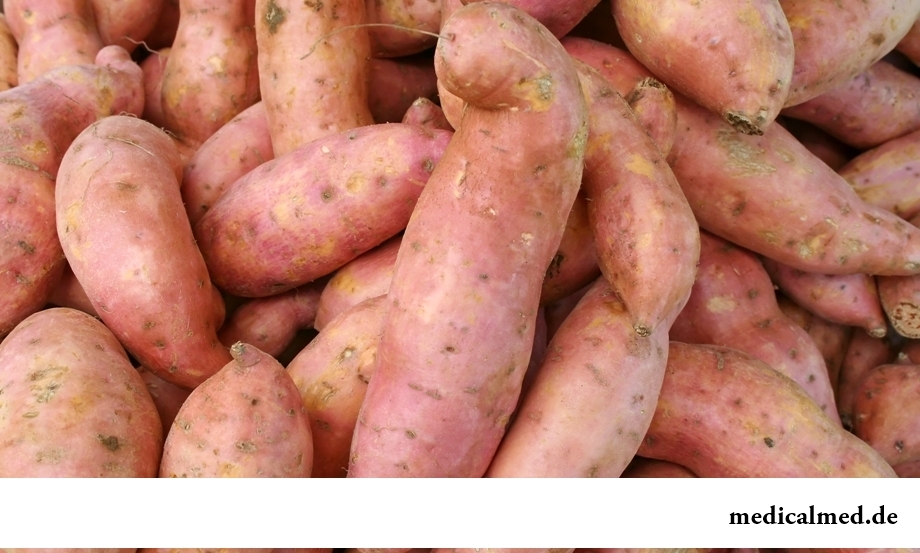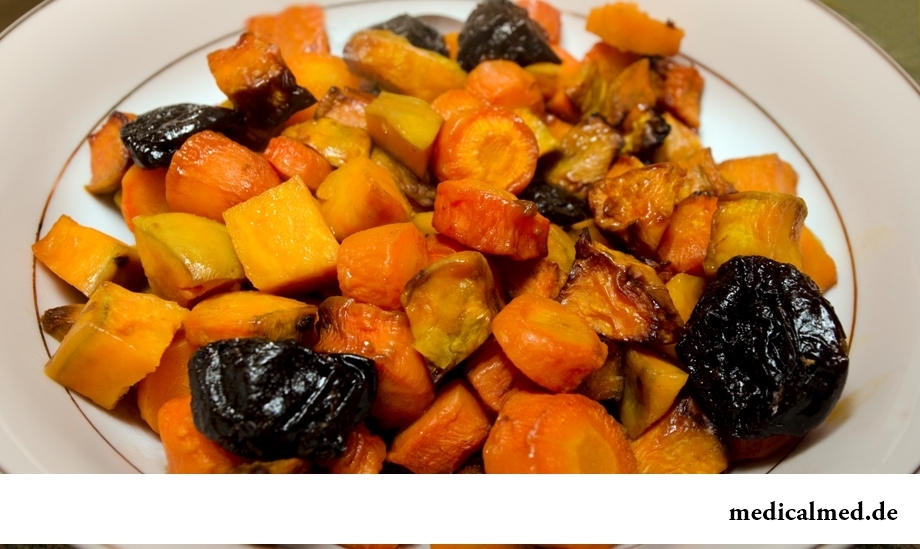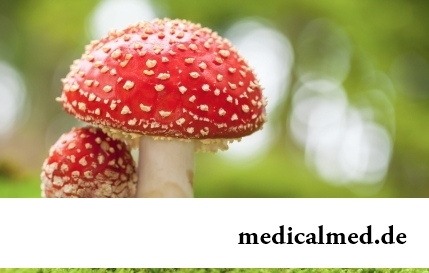





Yam
Yam – the collective name of several species of the plants of a sort a Chinese yam having edible tubers.

Roots of a yam of a cylindrical form are also rich in carbohydrates that allows a plant to survive in very arid climate. They can reach up to 1,5 meters in length and weigh to 70 kilograms. Edible tubers have a rough thin skin which is difficult for cleaning, but which is softened after heating. The thin skin differs on color depending on a grade of a yam and happens dark brown or light pink shades. Roots of a yam contain about 20% of starch, 75% of water, 0,1% of B1 vitamin, 10-15 mg of vitamin C. Tubers of a yam can reach 5-10 kg in weight and depending on a grade happen white, yellow or violet colors.
Plant leaves, as a rule, big bright green in the form of heart. They can sometimes be a violet shade in connection with the anthocyanins which are contained in them.
Yam – the gonochoristic culture having both female, and men's flowers on one plant. The yam irregularly blossoms that does pollination process difficult and causes low level of production of fruits and seeds. The plant vegetatively, by change of rhizomes breeds. An elevated part of a yam can reach up to 3 meters in height.
The yam grows in the countries with tropical and subtropical climate, is generally grown up as a food stuff in Africa (the continent with the highest production), the Southern Asia, on islands of the Pacific Ocean and the Caribbean region. The plant does not transfer frosts.
In the nature there are more than 600 grades of a yam, 95% of these cultures are grown up in Africa. The most widespread and known grades of a plant are:
- Chinese yam;
- Lukovitsenosny yam;
- The Chinese yam is edible;
- Winged yam;
- The Chinese yam is roundish;
- White yam;
- Yellow yam.
Wild yam
The wild yam is a kind of a yam which contains in the roots and bulbs диосгенин, used in laboratories for creation of steroids. As a rule, the wild yam is not eaten because of bitter taste.
The wild yam contains chemical which can be in vitro turned into various steroids, such as estrogen. It is often positioned as a natural alternative of estrogen and used at a premenstrual syndrome, menstrual pains, osteoporosis, dryness of a vagina after a menopause, for increase in vital energy and sexual desire at men and women. The wild yam possesses some similar to estrogen activity, but actually in an organism does not turn into them.
The wild yam, according to doctors, is efficient means at treatment of a divertuculosis, a gall bladder and a pseudorheumatism.
Tubers of some species of a wild yam are a source of a diosgenin and steroid sapogenin. Taken диосгенин it is used for synthesis of cortisol, a pregnenolon, progesterone and other steroids. Drugs on their basis are used as the combined oral contraceptives.
Cream on the basis of a wild yam, according to doctors, reduce inflows during a menopause.
In east Indian traditional medicine the wild yam is used for treatment of sexual and hormonal problems. The Chinese herbalists use a wild yam for treatment of rheumatism, asthma, gastrointestinal and uric diseases long ago. The wild yam is also used in the American traditional medicine at treatment of cough. Some sources assume that indigenous Americans and early settlers used it for simplification of enterospasms and gastric gripes.
Use of a yam
In China the wild yam is considered the plant calming and stimulating work of a stomach and spleen which has tonic effect on lungs and kidneys. Tubers contain cordianine which accelerates process of healing of wounds. The yam root is traditionally applied in the Chinese medicine to treatment of a hyperthyroidism, nephrite and a diabetes mellitus.
At use inside the yam, according to reviews, takes off fatigue, promotes loss of weight, improves appetite and digestion. Also, according to reviews, the yam is effective at treatment of chronic diarrhea, asthma, dry cough, frequent or uncontrollable an urination, emotional instability.
Outwardly the yam is applied at treatment of ulcers, furuncles and abscesses. Juice of leaves is used at treatment of wounds for stings of snakes and scorpions.
Contains in roots of the majority of species of a wild yam диосгенин which is widely used in modern medicine for production of progesterone and other steroid drugs, contraceptives, at treatment of various frustration of generative organs, the alimentary system, at asthma and arthritis, and also by production of vermifuge and antitoxic medicines.

Since ancient times the yam was grown up in coastal areas of Africa and used in food by the African fishermen. Tubers of some kinds of a yam can be stored up to six months at high temperature that does them by a valuable resource for the annual period of deficit of food at the beginning of a rainy season.
In Africa the yam is universal vegetable which is cooked on a grill, fry, cook, bake, smoke, and in a grated look add to desserts. The crushed tubers use for preparation of the flour having the pleasant aroma reminding potatoes. Yam flour is the main raw materials for preparation of the African bread.
Contraindications
Use of a wild yam is safe for most of people, however at the use in large numbers can make sick and vomiting.
The breast cancer, uterus and ovaries, endometriosis and a hysteromyoma are a contraindication to a wild yam as he can act as estrogen.
Also a contraindication to a wild yam is deficit of protein. People with deficit of protein have the increased risk of formation of blood clots, and the wild yam can increase this risk.
Most of women is capable to derive more pleasure from contemplation of the beautiful body in a mirror, than from sex. So, women, you aim at symmetry.

The phenomenon of the panic attack is known long ago, but the reasons of its emergence still are up to the end not found out. It is established that more than 30%...
Section: Articles about health
An eye of the person daily experiences considerable strain. The problem of preservation of sight is for many years directly connected with a question of supply of tissues of eye enough oxygen and nutrients. This task is carried out by small vessels – capillaries. For holes...
Section: Articles about health
Iodine - one of thirty most important microelements in our organism. The main role of iodine consists in synthesis of thyroid hormones of a thyroid gland - the substances which are responsible for the majority of exchange processes of an organism. It is known that thyroid hormones consist of iodine more than for 65%. The lack of iodine leads to decrease in production of hormones and, as a result, development of a hypothyroidism. The long condition of deficit can become a source of problems of the cardiovascular, bone, digestive SI...
Section: Articles about health
Deciding to get rid of an addiction, not all imagine what effects it is necessary to face. Process of refusal from ку...
Section: Articles about health
The summer of this year in Russia was very ambiguous. Regions suffered from a merciless heat, from pouring rains, the hail from time to time dropped out, then there was again a heat which alternated with rainfall again. Many people suffer from such sharp changes of weather...
Section: Articles about health
It is difficult to revaluate importance of kidneys for an organism. These bodies not only perform work on purification of blood of decomposition products and removal of excess liquid. They are responsible also for production of some hormones necessary for maintenance of a normality of a bone tissue, and also for a producing red blood cells – erythrocytes....
Section: Articles about health
Smoking not only exerts a negative impact on the state of health of the consumer of tobacco products, but is a source з...
Section: Articles about health
Life does not indulge the modern woman special emotional comfort and carelessness. The fatigue, troubles at work, misunderstanding in a family and various illnesses immediately affect a condition of hair and skin. And to look safe and attractive so хоч...
Section: Articles about health
Each failure in work of bodies and systems of a human body is, as a rule, shown by the whole complex of symptoms. In particular, malfunctions with health often cause emergence of cosmetic defects in the form of rashes on a face. Experienced doctors know that localization of heat-spots usually depends on what disease the patient has....
Section: Articles about health
The technique of acupuncture (acupuncture) is used in the medical purposes more than three and a half millennia. It widely races...
Section: Articles about health
The advantage of swimming for the person is so high that this sport is not only the most popular, but also is widely applied in medicine and rehabilitation processes. If you look for for yourself the occupation allowing pleasantly and to spend time, then swimming with advantage...
Section: Slideshow
They say that to ensure health and longevity of people it is obliged. Really, at competent approach to these questions, minimization of an adverse effect of many factors does not represent a special problem. Practically everyone has an opportunity to play sports, to pick up an optimum operating mode and rest, to adjust healthy food, to refuse addictions. It is more difficult to exclude hit in an organism of harmful substances through a respiratory organs: not all are able to afford to live in the area with хо...
Section: Articles about health
Kidneys perform the most important function of clarification of blood from those products of metabolic processes which cannot be used орг...
Section: Articles about health
Cold, puffiness of a nose, itch, the watering eyes - characteristic symptoms of the allergic rhinitis resulting from hit of allergens (pollen, house dust, hair of animals, etc.) on a mucous membrane of a nose. Unpleasant feelings often deliver беспоко...
Section: Articles about health
About influence of fasting days on an organism it is told much – both about advantages, and about shortcomings. It is considered that fasting day in the form of a short-term monodiet is useful, promoting effective removal of slags from an organism whereas irregular, excessively long, spontaneous fasting days lead only to deterioration in health. How to derive benefit from the sparing diet and not to do much harm to itself? Let's consider the main advantages and shortcomings of fasting days and their influence on an org...
Section: Articles about health
For the help to doctors in the choice of optimal solutions for treatment of various diseases the Cochrane scientific organization (Cochrane) will see off совм...
Section: Articles about health
Some people consider what for medicine of the 21st century of secrets in the field of health of the person almost does not exist. It absolutely not so. The more answers scientists receive, the more the most difficult questions are raised for them by life. Besides, there are diseases, not объясн in any way...
Section: Articles about health
Olive oil – the product capable to make a powerful contribution to health of the person if it includes it in the diet. The rich vitamin composition of oil does it by a product number one from many diseases including from deadly. Only two tablespoons of oil from olives in day prevent emergence of diseases of vessels and heart, cancer, problems with digestion, presenilation, a depression and many other illnesses which treatment would demand a lot of time and forces. Let's consider on...
Section: Articles about health
The next flu epidemic leads to the next panic, from year to year we give in on these manipulations: professionally alarming goal...
Section: Articles about health
Venereal diseases in medicine are called the infections which are transmitted preferential sexually, now they and are called - infections, sexually transmitted, or STD. Among them is also life-threatening. In spite of the fact that majority...
Section: Articles about health
High temperature - a frequent symptom of such widespread diseases as a SARS, quinsy, pneumonia, etc. To reduce heat, having facilitated a condition of the patient, doctors recommend to accept antipyretics, however their use is not always possible. Too frequent use of these drugs can lead to allergic reactions, and also overdose, causing poisoning. It happens also that there are no antipyretics simply in the house. In these situations it is pertinent to use it...
Section: Articles about health
Mushrooms - the surprising inhabitants of our planet having a set of wonderful qualities. Thanks to one of them, a mold mushroom of Penici...
Section: Articles about health
The name of this disease precisely reflects the problem reason: it consists in the bra fastener pressure upon a certain zone of a back. At the same time one of vertebrae of chest department of a backbone is as if blocked and loses mobility, and falling on it is nude...
Section: Articles about health
With age in a human body harmful substances collect. We receive them with food and water, at inhalation of the contaminated air, reception of medicines, use of household chemicals and cosmetics. A considerable part of toxins accumulates in a liver which main function is continuous purification of blood. This body begins to knock as any got littered filter, and efficiency of its work decreases....
Section: Articles about health
White teeth and the Hollywood smile – a dream of many people. Long time was considered that a plaque on teeth and change of their color – destiny of those...
Section: Articles about health
The state of health of the person depends on many factors. One of the most important is the constant, but not exhausting a physical activity. In the presence of various illnesses specialists often advise patients to do swimming which by right borrows ведущ...
Section: Articles about health
All know that self-treatment is dangerous. However absolutely it is almost impossible to do without it. Rate of modern life does not allow to handle each small trouble to the doctor and information on ways of independent delivery of health care is quite available. Means, all of us have only one: to learn to give this help competently and in those limits in which it is possible for the person who does not have vocational education....
Section: Articles about health
